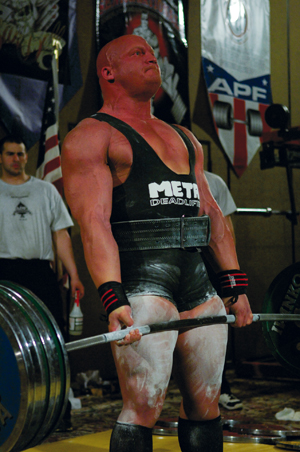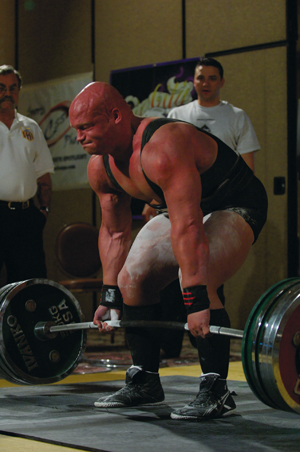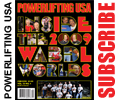WESTSIDE TRAINING
June 2010 - Vol. 33 No. 8
DEADLIFT TRAINING
by Louie Simmons | 614.801.2060
www.westside-barbell.com
Paul Childress said that a big squatter is not always a big deadlifter, but a big deadlifter is almost always a big squatter. How do you build a big deadlift if you weren’t born with one? Ernie Frantz always said that to increase your deadlift, you should just deadlift.
Westside has always relied on a lot of special exercises, but
we have done more deadlifting in the form of speed pulls in the
last few years. After the speed day for squatting, we will do
multiple sets of deadlifts off the floor with bands over the bar.
We have always done a lot of rack pulls on max effort day, but
in 2007, we started doing rack pulls with bands—a monster mini
alternated with light Jump-Stretch bands. They are quadrupled
up to produce a large, fast-acting accommodation of resistance.
This style of rack pulling is done for max effort work, working
up to a max single, but also for up to 10 sets of 3–5 reps done
with a conventional stance. The multiple sets are done after speed
squat sets. This has added up to 15,000 pounds of volume in the
precise deadlift muscles. I just pulled a 670-pound deadlift.
My max band pull with the plates 4 or 6 inches off the floor is
430 with light bands and 530 with monster mini bands.
 Luke Edwards’ best is 585 pounds with light bands and 675 pounds
with monster mini bands. Luke’s total volume can approach 20,000
pounds of work. The system builds a strong lock-out, a powerful
start, and a very strong grip. Luke has an 840 official deadlift
at around 260 pounds, a 920 squat, and a 2226 total. The bonus
is that his squat form has changed to a more mechanically effective
method that pushed his 920 squat to 1025 at the same 242 bodyweight.
His deadlift program is to alternate the pause sets of 3–5 reps
in the power rack with ultra-wide sumo band pulls off the floor.
A test of progress is to pull real weight off the floor ultra-wide,
wider than a normal sumo stance, or pull in a rack off low pins.
Luke has made 705 pounds for 3 reps ultra-wide and 805 pounds
with the plates 2 inches off the floor and 845 pounds with the
plates 4 inches off the floor. The multiple sets with bands in
the power rack for 3–5 reps with a conventional stance are a builder.
So are the ultra-wide deadlifts with bands, with feet to the plates,
for not only the deadlift but also the squat. They do this by
building all the crucial muscles that increase the squat.
Luke Edwards’ best is 585 pounds with light bands and 675 pounds
with monster mini bands. Luke’s total volume can approach 20,000
pounds of work. The system builds a strong lock-out, a powerful
start, and a very strong grip. Luke has an 840 official deadlift
at around 260 pounds, a 920 squat, and a 2226 total. The bonus
is that his squat form has changed to a more mechanically effective
method that pushed his 920 squat to 1025 at the same 242 bodyweight.
His deadlift program is to alternate the pause sets of 3–5 reps
in the power rack with ultra-wide sumo band pulls off the floor.
A test of progress is to pull real weight off the floor ultra-wide,
wider than a normal sumo stance, or pull in a rack off low pins.
Luke has made 705 pounds for 3 reps ultra-wide and 805 pounds
with the plates 2 inches off the floor and 845 pounds with the
plates 4 inches off the floor. The multiple sets with bands in
the power rack for 3–5 reps with a conventional stance are a builder.
So are the ultra-wide deadlifts with bands, with feet to the plates,
for not only the deadlift but also the squat. They do this by
building all the crucial muscles that increase the squat.
The ultra-wide sumo with just bar weight is a tester. The rack
pulls with plates off the ground 2 ½, 4 ½, or 6 ½ inches are also
a tester. By doing this style of training there is little emotional
stress. It is truly a training max. Many times one becomes too
psyched up, which leads to a long recovery time emotionally, especially
if you miss a lift. After deadlifting, Luke will do 4–6 sets on
the Reverse Hyper machine. He will alternate glute/ham raises
with heavy weight for 4–8 reps with doing 200 leg curls with 10
or 20-pound ankle weights. The high reps will build and thicken
the ligaments and tendons.
 To withstand the high volume/high-intensity training, sled pulls
play a large role in Luke’s training. He uses heavy weight early
in the week to build absolute strength in the legs, back, and
hips. Monday is max effort day. The weight is decreased during
the week’s training, and the trips are increased. This will build
strength endurance. Late in the week the sled pulls are lightened
again for restoration or a warmup for Friday speed development
day. The sled pulls are done for 60 yards. The heaviest weights
are done for 6–8 trips. The moderate sled pulls are done for 8–12
trips, and the lightest pulls on Thursday or Friday are again
done for 6–8 trips. The heavy pulls are done immediately after
the barbell work. After the light pulls on Friday he is ready
to squat. Luke does a lot of leg raises, and he also does sit-ups
with a 6-inch foam roller under his low back. Side bends conclude
his ab work.
To withstand the high volume/high-intensity training, sled pulls
play a large role in Luke’s training. He uses heavy weight early
in the week to build absolute strength in the legs, back, and
hips. Monday is max effort day. The weight is decreased during
the week’s training, and the trips are increased. This will build
strength endurance. Late in the week the sled pulls are lightened
again for restoration or a warmup for Friday speed development
day. The sled pulls are done for 60 yards. The heaviest weights
are done for 6–8 trips. The moderate sled pulls are done for 8–12
trips, and the lightest pulls on Thursday or Friday are again
done for 6–8 trips. The heavy pulls are done immediately after
the barbell work. After the light pulls on Friday he is ready
to squat. Luke does a lot of leg raises, and he also does sit-ups
with a 6-inch foam roller under his low back. Side bends conclude
his ab work.
Remember Friday speed squats are done for 6–8 sets on average
for doubles. Speed pulls are done in a rack with a conventional
stance with 250 or 350 pounds of band tension. The weight ranges
from 315 to 405 pounds for 6–10 sets of pause reps for sets of
3 or 5 reps. He will alternate the rack work with ultra-wide sumo
pulls with his feet out to the plates. This makes Friday’s workout
a very high volume/moderate intensity workout that can be over
20,000 pounds. On max effort day Luke will alternate good mornings
with low special-bar squats or a max rack pull. Here are his best
pulls: 805 pounds 2 ½ inches off the floor; 845 pounds 4 ½ inches
off the floor, and 875 pounds 6 ½ inches off the floor. You notice
the heaviest rack pull is only 35 pounds over his best pull of
840 pounds. His best pause 3 in the ultra-wide sumo is 705 pounds
for 3 reps. So, what is Luke’s secret? Hard work. My advice to
you is to get to it—and good luck.
*photos courtesy PL USA


